Serendip is an independent site partnering with faculty at multiple colleges and universities around the world. Happy exploring!
May Day in its Hay Day
I choose this photo because of how it representst he past as well as the present. This is a picture of the first May Day ever held at Bryn Mawr. It was held in the year 1900. I choose it because it helps to capture the essence of Bryn Mawrs community, as a fun loving group of women that like to have a good time. During parade night I felt that same essence of the community first hand, everyone wanted to be a part of the tradition and enjoy it. One site that I have choosen to revist throughout the year is the campus green. I feel that in the photo above that huge area of open space symbolizes the freedom Bryn Mawr women have and the green on campus signifies that as well. Also since the green is currently under construction it will be an interesting this to revisit throughout the year because it will be constanly changing.
here is a link to the imgae: http://www.lowermerionhistory.org/photodb/full/164-2.jpg
I do not know why the image is not working.


Kate the Great
This image of Katharine Hepburn was the picture that I used as my visualization of the Bryn Mawr campus for my essay on Friday. It’s a photo from Hepburn’s acting days, and one that I thought could easily be associated with Bryn Mawr. Throughout my short time here, I’ve heard Hepburn, who graduated from Bryn Mawr in 1928, referred to numerous times in connection with the college. A quote of hers is on a wall in the Student Center, the Katharine Houghton Hepburn Center is named after her (and her mother), and she is one of the most famous Bryn Mawr graduates. (And the administration is awfully proud of that!). I didn’t think that this picture could possibly encapsulate all that there was to Katharine Hepburn. Even if it did, though, it also wouldn’t be able to accurately describe Bryn Mawr. Although I think that the community of Bryn Mawr makes us so special, I also think that as individuals, we are extraordinary, but only one of us can’t encompass all that there is to Bryn Mawr and its community. I have begun to associate one special tree with Bryn Mawr, though. It’s a weeping birch that we sat next to on our first outdoor class, and I’ll be sitting in it and next to it this semester.

Small Maps, Big Maps

I chose this image because I believe it represents the history of this institution, which foregrounds much more about the college than a map ever could. The Harriton House is actually located behind Schwartz, and is part of one of my longer cross-country runs. The mansion was originally constructed by Quaker Rowland Ellis, who named the land Bryn Mawr, which means “high hill” in Welsh. When the title was found in records years after Ellis had been forced to sell the property, it was decided that the township surrounding the estate would be named Bryn Mawr. Ellis’ uncle, John Humphrey, owned a handsome plot of land adjoining that of his nephew that now is Bryn Mawr College. Discovering the Harriton House on one of my runs helped me put my small window of perspective in relation to a more universal perspective of the world—in other words, my personal map in comparison to a much larger map. I use the corner between Harriton Avenue and Old Gulph Road as a reference point on my runs, while the Harriton House is a cornerstone of Bryn Mawr’s history.

Our Colorful Planet and our Limited Language
Green
OED:
I. With reference to colour.
1. Of a colour intermediate between blue and yellow in the spectrum; of the colour of grass, foliage, an emerald, etc.
Freq. with prefixed nouns or adjectives denoting a particular shade. apple, bottle-, dark, emerald-, grape-, grass-, lettuce, olive-, pea-, sea-green: see the first element. See also sense B. 4a.
a. Designating growing vegetation, grass, etc.
dictionary.com:
1. of the color of growing foliage, between yellow and blue in the spectrum: green leaves.
2. covered with herbage or foliage; verdant: green fields.
3. characterized by the presence of verdure.
4. made of green vegetables, as lettuce, spinach, endive, or chicory: a green salad.
Miriam-Webster:
1: of the color green
2a : covered by green growth or foliage <green fields>
b of winter : mild, clement
c: consisting of green plants and usually edible herbage <a green salad>
3: pleasantly alluring
4: youthful, vigorous
5: not ripened or matured <green apples>
6: fresh, new
Blue
OED:
1. a. The name of one of the colours of the spectrum; of the colour of the sky and the deep sea; cerulean.

Anthropocentric, Interdependence, Adaptation
I have chosen three words to explore: anthropocentric, interdependence, and adaptation.
Anthropocentric had definitions which highlighted different elements of the words in 3 dictionaries, the OED, Merriam Webster, and Dictionary.com. I picked out the definitions that emphasized different aspects of the word that might prove useful as we proceed with this class.
OED: Centring in man; regarding man as the central fact of the universe, to which all surrounding facts have reference.
MW: Interpreting or regarding the world in terms of human values and experiences.
Dictionary.com: Assuming human beings to be the final aim and end of the universe.
Etymonlin (Etymology): 1822, from inter- + dependence.
So these definitions show anthropocentric to be a word referring to how people view the world through a specifically human-focused lens. People whose decisions and thoughts are based on how humans fare in the world or how the environment should be tweaked and treated with specific regard to human life and convenience would be referred to as anthropocentric.
Moving on to interdependence:
A door to memory and beyond
the picture is upside down...
Solnit wrote, “No representation is complete”, no picture can fully visualize Bryn Mawr College. However, I would like to think the picture I chose - a photo of the green in front of Thomas Great Hall on Parade Night - as a door to that magical event, to my memories and to future thrilling experiences.
For so many years has Thomas Great Hall witnessed the welcoming of new students and listened to the class song the seniors sang on the senior steps… The traditions are more than memorable and enjoyable spectacles that divert me from the intensity of study. They are crucial events that help create a sense of Sisterhood among Mawters that lasts beyond the confines of the four years of college. They are the highlights of every Mawter’s Life. When I become a grandmother, I would proudly show this picture to my grandchildren and tell them about the traditions I experienced at Bryn Mawr. Right now, I like to look at the picture to “re-experience” Parade Night and keep myself amid of expectation for more exciting college experiences.

Sustainable, Interaction, Resilience
Sustainable-
Oxford English Dictionary (online): Etymology. It comes from the earlier adjective sustenable and French forms of the word. First used as early as the 1600s
Definition(s): - Capable of being endured or borne; bearable
- Capable of being maintained or continued at a certain rate or level
Merriam-Webster Dictionary (online): circa1727
Defintion(s): - Capable of being sustained
- Of, relating to, or being a method of harvesting or using a resource so that the resource is not depleted or permanently damaged
- Of or relating to a lifestyle involving the use of sustainable methods
Dictionary.com: Origin: sustain + -able
Definition(s): - Capable of being supported or upheld, as by having its weight borne from below
- Pertaining to a system that maintains its own viability by using techniques that allow for continual reuse
- Able to be maintained or kept going, as an action or process
- Able to be supported as with the basic necessities or sufficient funds
Intereaction-

Sustainable, Interaction, Resilience
Sustainable-
Oxford English Dictionary (online): Etymology. It comes from the earlier adjective sustenable and French forms of the word. First used as early as the 1600s
Definition(s): - Capable of being endured or borne; bearable
- Capable of being maintained or continued at a certain rate or level
Merriam-Webster Dictionary (online): circa1727
Defintion(s): - Capable of being sustained
- Of, relating to, or being a method of harvesting or using a resource so that the resource is not depleted or permanently damaged
- Of or relating to a lifestyle involving the use of sustainable methods
Dictionary.com: Origin: sustain + -able
Definition(s): - Capable of being supported or upheld, as by having its weight borne from below
- Pertaining to a system that maintains its own viability by using techniques that allow for continual reuse
- Able to be maintained or kept going, as an action or process
- Able to be supported as with the basic necessities or sufficient funds
Intereaction-

Code Switching?
While reading The Silenced Dialogue: Power and Pedagogy in Educating Other People’s Children, there was not a time where I did not find myself connecting to the concept she writes about.
I first began connecting with her text when she speaks of the difference between students of color and the white students in a classroom. Although it made me uncomfortable at times, specifically when she spoke about the difference between Black and White mothers (although I find it to be true), I loved the way she explained the standards needed to be met for the teacher to have authority between these groups. I loved it because I can completely see this taking place in my high school. I use teacher subs for example; there was not a student in my school that gave them authority. The subs simply sat there and took attendance – but that was is. I spoke to a friend of mine that attended a suburban school; she said that in her school this was nowhere near to be the case.

Issues of Representation and Misrepresentation
Representation for others seems to be an inescapable thing, both in language and in life. We are represented by others politically, academically and in media. When Beyoncé sings “Run the World (Girls)”, she sings “Work my 9 to 5/ better cut my check/ this goes out to all the women getting it in” in attempt to speak to working women; however she herself does not work a typical 9 to 5 job. Representation pervades our lives in a way that seems unavoidable. We as students are constantly being spoken for- many of the articles we have been reading about education speak for us and attempt to dissect and interpret the desires of students; our desires. Even if the point of the article is to say that students should not have to be constantly redefined into a representation; there is still a certain degree to which we are not only being spoken for but assumed as a unified category. “Students” itself feels simplified; there is so much diversity that is made invisible by this generalization. This seems to be one of the main problematic side effects of representation, in addition with misrepresentation and misinterpretation. Even as I write this, I am aware of the implications of using “we” and “our” to refer to people on a general level, and that I myself am attempting to speak for others. My reference to Beyoncé is beginning to feel like a transgression in the sense that I assume a particular interpretation of her words and that I assume she does not work a 9 to 5 job.


